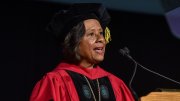This year’s Radcliffe Day panel, “The Long Arc of Equality and Justice in America,” drew its name from one of the most frequently quoted adages in American history: Martin Luther King, Jr.’s claim that “the arc of the moral universe is long, but it bends toward justice.” The quotation implies that history is a narrative of constant progress—even if that progress might be slow. “But is that true?” asked moderator Melissa Murray, a law professor at New York University School of Law. “In our own history, the project of perfecting democracy has not been one of consistent forward progress, but rather has been a series of oscillating moves toward and against this kind of progress.”
The democracy King envisioned, Murray continued, was pluralistic: “multiracial, multiethnic, multifaith.” And though the idea of a pluralistic democracy may seem intuitive today, democracy hasn’t always been this way: the earliest democracies of ancient Greece were characterized by homogeneity among participants. While people may have differed in their ideas, Murray said, “they shared a common identity, a common nationality, and a vision of the good life.” Those commonalities excluded some people from participating, but helped establish a common ground that allowed democracy to flourish. “In many ways, contemporary America lacks some of those common underpinnings,” Murray said. “Many Americans believe we increasingly lack a shared vernacular about what it means to be an American.”
Panelists discussed how to reconcile these two ideals—pluralism and common values—that animate American democracy, and the role that the law plays in that effort. Murray asked whether identity-based advocacy still has a place in the movement toward justice, or whether such “advocacy is going by the wayside in favor of broader coalition movements.” Two panelists who work at identity-based advocacy groups argued that these groups still have a role to play. “It’s not us who are necessarily pushing identity—we’re responding to efforts around racial identity,” said Nina Perales, vice president of litigation for the Mexican American Legal Defense and Educational Fund. She pointed to book bans in Texas, where she lives, arguing that these laws are justified by a need to protect “white people from… a painful response to learning about history.” When laws use race as a basis for advancing injustice, she said, it’s necessary to use race to respond.
But identity isn’t just a tool to be reclaimed from bad actors. “Identity remains important to people as a source of inspiration, joy, and connection,” said Mary Bonauto, senior director of civil rights and legal strategies at GLBTQ Legal Advocates & Defenders (GLAD). “It’s not only salient in terms of being inspirational to people,” she continued; it’s also “needed… when people become wedge issues, rather than people.” Bonauto pointed to legislation across the country restricting trans people’s access to health care and preventing teachers from discussing gender and sexuality in school. In this context, identity-based activism can help marginalized people see themselves as members of the American project. During a lifetime of organizing, “I have really seen a difference,” she said, “in terms of how LGBTQ see themselves as citizens, and how they see themselves as belonging in this nation’s fundamental promises about liberty and equality for all.”
What role does the Supreme Court play in this effort to include more people in a community of shared values? During the era of the Warren Court, many Americans saw the court as an engine of social change. “In this moment,” Murray asked the speakers, “is the Court a vehicle in that effort to bend toward justice, or is it an impediment?” Adam Liptak, who covers the Supreme Court for the New York Times, answered for all the panelists: “In short, the initial answer is the latter.” The Court hasn’t always been as liberal as the Warren Court, he said. But when the Court, in Dobbs, revoked the constitutional right to abortion, it entered an unprecedented era of rolling back progress, not just halting it. “You would think that, whatever else can be said about the Court, it ought to be a one-way ratchet,” said Liptak, “that as equality is increased, it should no longer be under threat.” But in his Dobbs concurrence, Supreme Court Justice Clarence Thomas wrote that the decision could pave the way for rolling back other rights, including the rights to contraception and same-sex marriage—signaling an era of backwards movement.
Given the threat to these rights, speakers explored other avenues for progress. Jerome Foster II—an environmental activist and, at 22, the youngest ever White House Environmental Justice Advisory Council member—spoke about the importance of grassroots organizing. Through protests and other activism, “we’re able to change people’s perceptions about what is morally just,” which he hopes can have downstream effects on law and policy. But that’s not always the case, other speakers pointed out: the law sometimes doesn’t reflect public opinion, as in the case of abortion. This is often a result of gerrymandering, Murray said, which is set to remain a longstanding issue—on May 23, the Supreme Court ruled that South Carolina could continue to use a congressional map that a lower court had deemed a racial gerrymander. Thomas signaled future similar decisions, Murray said, when he wrote that the Court has no power to assess claims of racial gerrymandering.
The power of interpreting the law, then, can’t rest only in the hands of the Supreme Court. Also important is forging a form of “popular constitutionalism,” Murray said: “[translating] the Constitution and its promises into a vernacular that people… can see themselves in, so [those promises] can actualize and manifest into policies.” The Court, Liptak said, can play a role in that effort: even as it issues decisions that may roll back rights, dissents can shape public understanding of those decisions and whether they were correct. For example, the dissents of Justice Sonia Sotomayor—who was in the audience to receive the Radcliffe Medal later that day—often “shine a bright spotlight on flaws in the criminal justice system. So, there’s a lot that goes on in the Court that’s above—or sideways to, or horizontal to—the actual dispute being resolved.”
Perhaps, speakers suggested, the backlashes to progress seen across the country—whether the Supreme Court’s decisions or book bans—are rooted in concern about “the persuasive power of being able to identify with another person’s experience,” Murray said. “When you can identify and see and understand another person’s experience, you can empathize with them.” Maybe, she continued, it’s precisely this power that motivates book bans: “that these books might allow us to become more cohesive.” Books representing LGBTQ children hold that promise, Bonauto said: seeing yourself represented in a book reflects “your worth and your relevance,” while a lack of those books “creates a vacuum where other narratives can fill the void.” Books also have the potential to empower children to become active citizens: Perales noted that many of the books banned in Texas are about the Civil Rights Movement, including Separate is Never Equal, a children’s book by Duncan Tonatiuh about the desegregation case Mendez v. Westminster.
The powers preventing these books from reaching children may seem remote and unstoppable. But the decision about which books to ban often takes place at the local level. “I have been semi-encouraged,” Bonauto said, “that there have been plenty of local school boards, in very conservative places, that kept those books on selves.” This has been possible, she continued, because of grassroots, local activism and community efforts. Despite the seemingly overwhelming power of the Supreme Court, “there is no reason not to engage locally, talk to people, find that common ground where you agree.”









